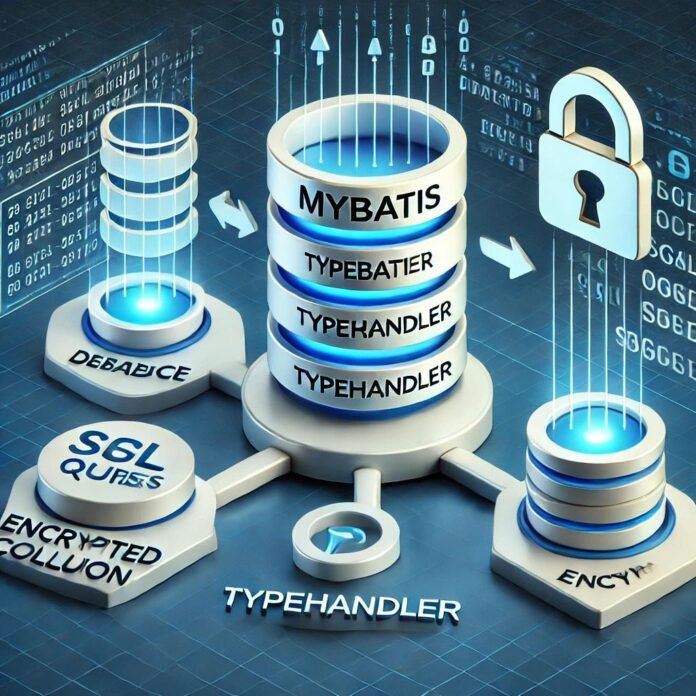Introduction
As data security issues grow in importance, encrypting private data in databases has become absolutely essential for developers. Popular Java persistence framework MyBatis provides a versatile method for managing database operations and, with TypeHandlers, flawless encryption and decryption of data. This post will discuss how to properly use MyBatis TypeHandler encryption such that sensitive data stays safe while preserving good database performance.
MyBatis Type handler is what?
Java types and database column types are converted between using MyBatis TypeHandler. It lets developers specify unique actions for database access and storage of values. Using TypeHandlers allows developers to apply encryption and decryption straight into MyBatis, therefore guaranteeing the persistence layer protection of sensitive data.
Why Use Encryption in MyBatis?
- Compliance with data security
Sensitive data must be encrypted per laws including GDPR, HIPAA, and CCPA. By using encryption in MyBatis, one guarantees adherence to these regulations. - Prevention of Data Leaks
Encrypted value storage in the database offers an additional degree of protection and makes it more difficult for attackers to access pertinent data should a breach develop. - Perfect Combining
By means of MyBatis TypeHandler for encryption, one guarantees that, upon database interaction, encryption and decryption procedures are automatically executed, therefore simplifying development and lowering security concerns.
Using MyBatis TypeHandler’s Encryption
First step: List encryption dependencies.
Java’s JCE (Java Cryptography Extension) or packages like Bouncy Castle for sophisticated cryptographic operations might help you to apply encryption. In your Maven pom.xml, incorporate the following dependencies whether using AES encryption:
<dependency>
<groupId>org.bouncycastle</groupId>
<artifactId>bcprov-jdk15on</artifactId>
<version>1.70</version>
</dependency>
Second step: Design an Encryption Utility Class.
import java.util.Base64;
import javax.crypto.Cipher;
import javax.crypto.KeyGenerator;
import javax.crypto.SecretKey;
import javax.crypto.spec.SecretKeySpec;
public class EncryptionUtil {
private static final String ALGORITHM = “AES”;
private static final String SECRET_KEY = “MySuperSecretKey123”;
public static String encrypt(String value) throws Exception {
Cipher cipher = Cipher.getInstance(ALGORITHM);
SecretKeySpec keySpec = new SecretKeySpec(SECRET_KEY.getBytes(), ALGORITHM);
cipher.init(Cipher.ENCRYPT_MODE, keySpec);
return Base64.getEncoder().encodeToString(cipher.doFinal(value.getBytes()));
}
public static String decrypt(String value) throws Exception {
Cipher cipher = Cipher.getInstance(ALGORITHM);
SecretKeySpec keySpec = new SecretKeySpec(SECRET_KEY.getBytes(), ALGORITHM);
cipher.init(Cipher.DECRYPT_MODE, keySpec);
return new String(cipher.doFinal(Base64.getDecoder().decode(value)));
}
}
Third step: Implement Custom MyBatis TypeHandler.
import org.apache.ibatis.type.BaseTypeHandler;
import org.apache.ibatis.type.JdbcType;
import java.sql.PreparedStatement;
import java.sql.ResultSet;
import java.sql.SQLException;
public class EncryptedStringTypeHandler extends BaseTypeHandler<String> {
@Override
public void setNonNullParameter(PreparedStatement ps, int i, String parameter, JdbcType jdbcType) throws SQLException {
try {
ps.setString(i, EncryptionUtil.encrypt(parameter));
} catch (Exception e) {
throw new SQLException(“Encryption error”, e);
}
}
@Override
public String getNullableResult(ResultSet rs, String columnName) throws SQLException {
try {
return EncryptionUtil.decrypt(rs.getString(columnName));
} catch (Exception e) {
throw new SQLException(“Decryption error”, e);
}
}
@Override
public String getNullableResult(ResultSet rs, int columnIndex) throws SQLException {
try {
return EncryptionUtil.decrypt(rs.getString(columnIndex));
} catch (Exception e) {
throw new SQLException(“Decryption error”, e);
}
}
}
Fourth step: Register the TypeHandler within MyBatis configuration.
<typeHandlers>
<typeHandler handler=”com.example.EncryptedStringTypeHandler”/>
</typeHandlers>
Step five: Apply the TypeHandler to MyBatis Mapper fields.
<resultMap id=”UserResultMap” type=”User”>
<result column=”encrypted_column” property=”sensitiveData” typeHandler=”com.example.EncryptedStringTypeHandler”/>
</resultMap>
FAQs on MyBatis TypeHandler Encryption
- How does encryption with MyBatis TypeHandler work?
Before entering data into the database and decrypting it later on, MyBatis TypeHandler intercepts database interactions. - Should database encryption call for AES encryption?
Indeed, because of its great security qualities and efficiency, Advanced Encryption Standard (AES) is extensively applied for database encryption. - Can MyBatis TypeHandler let me apply several encryption techniques?
Through changes to the encryption utility class, you can substitute RSA, Blowfish, or another encryption technique for AES. - Does encryption of data influence database performance?
Indeed, encryption increases computational overhead. Still, effective database design and indexing techniques help to reduce performance effects. - Should the encryption key be lost, what results?
Losing the encryption key renders decryption impossible. Store encryption keys safely always with environment variables or a separate key management solution.
Conclusion
For persistent layer security of sensitive data, MyBatis TypeHandler encryption is a potent method. Custom TypeHandlers let developers easily include encryption into their MyBatis systems, therefore guaranteeing data security without major code modification. Following best practices can improve data security and compliance with security rules even further by means of robust encryption algorithms and securely managed keys.



